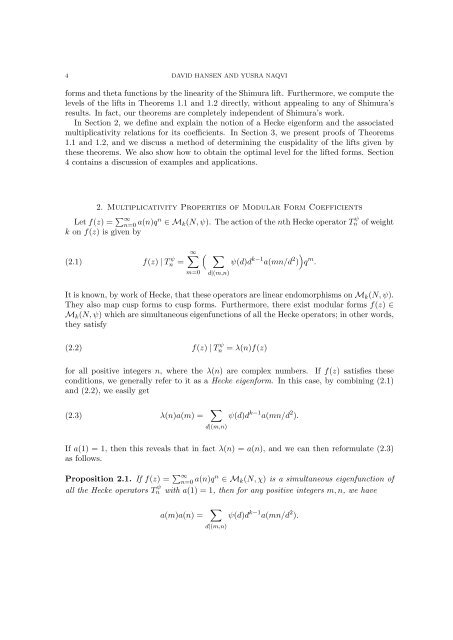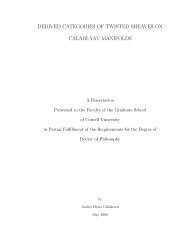Shimura lifts of half-integral weight modular forms - Department of ...
Shimura lifts of half-integral weight modular forms - Department of ...
Shimura lifts of half-integral weight modular forms - Department of ...
Create successful ePaper yourself
Turn your PDF publications into a flip-book with our unique Google optimized e-Paper software.
4 DAVID HANSEN AND YUSRA NAQVI<br />
<strong>forms</strong> and theta functions by the linearity <strong>of</strong> the <strong>Shimura</strong> lift. Furthermore, we compute the<br />
levels <strong>of</strong> the <strong>lifts</strong> in Theorems 1.1 and 1.2 directly, without appealing to any <strong>of</strong> <strong>Shimura</strong>’s<br />
results. In fact, our theorems are completely independent <strong>of</strong> <strong>Shimura</strong>’s work.<br />
In Section 2, we define and explain the notion <strong>of</strong> a Hecke eigenform and the associated<br />
multiplicativity relations for its coefficients. In Section 3, we present pro<strong>of</strong>s <strong>of</strong> Theorems<br />
1.1 and 1.2, and we discuss a method <strong>of</strong> determining the cuspidality <strong>of</strong> the <strong>lifts</strong> given by<br />
these theorems. We also show how to obtain the optimal level for the lifted <strong>forms</strong>. Section<br />
4 contains a discussion <strong>of</strong> examples and applications.<br />
2. Multiplicativity Properties <strong>of</strong> Modular Form Coefficients<br />
Let f(z) = ∞<br />
n=0 a(n)qn ∈ Mk(N, ψ). The action <strong>of</strong> the nth Hecke operator T ψ n <strong>of</strong> <strong>weight</strong><br />
k on f(z) is given by<br />
(2.1) f(z) | T ψ n =<br />
∞ <br />
m=0<br />
d|(m,n)<br />
ψ(d)d k−1 a(mn/d 2 <br />
) q m .<br />
It is known, by work <strong>of</strong> Hecke, that these operators are linear endomorphisms on Mk(N, ψ).<br />
They also map cusp <strong>forms</strong> to cusp <strong>forms</strong>. Furthermore, there exist <strong>modular</strong> <strong>forms</strong> f(z) ∈<br />
Mk(N, ψ) which are simultaneous eigenfunctions <strong>of</strong> all the Hecke operators; in other words,<br />
they satisfy<br />
(2.2) f(z) | T ψ n = λ(n)f(z)<br />
for all positive integers n, where the λ(n) are complex numbers. If f(z) satisfies these<br />
conditions, we generally refer to it as a Hecke eigenform. In this case, by combining (2.1)<br />
and (2.2), we easily get<br />
(2.3) λ(n)a(m) = <br />
d|(m,n)<br />
ψ(d)d k−1 a(mn/d 2 ).<br />
If a(1) = 1, then this reveals that in fact λ(n) = a(n), and we can then reformulate (2.3)<br />
as follows.<br />
Proposition 2.1. If f(z) = ∞<br />
n=0 a(n)qn ∈ Mk(N, χ) is a simultaneous eigenfunction <strong>of</strong><br />
all the Hecke operators T ψ n with a(1) = 1, then for any positive integers m, n, we have<br />
a(m)a(n) = <br />
d|(m,n)<br />
ψ(d)d k−1 a(mn/d 2 ).
















